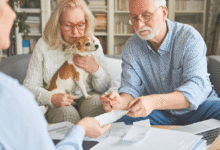
Pet Safety: Identifying Household Hazards and Preventing Accidents
Pet safety is not just a responsibility; it’s a commitment that pet owners owe to their furry companions. The home, while seemingly safe, can harbor potential hazards that may pose risks to our pets. In this comprehensive guide, we’ll explore the intricacies of pet safety, identifying common household hazards, and providing practical tips on creating a secure environment for our beloved pets.
Read More: Summer Pet Safety Checklist
Importance of Pet Safety

As pet owners, the well-being of our furry friends is paramount. Acknowledging the significance of pet safety is the first step toward creating a living space that is both nurturing and secure. By being proactive and informed, we can safeguard our pets from potential accidents.
Common Household Hazards
Before diving into the specifics, it’s crucial to understand the common hazards that might be lurking in our homes. From toxic substances to everyday items, being aware of these dangers lays the foundation for a pet-safe environment.
Identifying Potential Hazards
Kitchen
Toxic Foods
The kitchen, often the heart of the home, can harbor several hazards for our pets. Certain foods, such as chocolate, onions, and grapes, are toxic to them. Understanding which foods to keep out of their reach is vital in preventing accidental ingestion.
Cooking Appliances
Beyond food, cooking appliances present potential dangers. Hot stovetops and open flames can lead to burns or injuries. Implementing safety measures in the kitchen, such as using stove guards, ensures the well-being of both the pet and the owner.
Living Room
Electrical Cords
The living room, a hub of activity, may contain electrical cords that pose a risk to pets, especially those prone to chewing. Securing cords and providing alternatives, like chew toys, can mitigate the risk of electrocution.
Small Objects
Small items like toys, coins, or buttons can be attractive to pets but also pose a choking hazard. Keeping these items out of reach and providing pet-friendly toys helps minimize the risk.
Bathroom
Chemicals
The bathroom houses various household cleaners and toiletries, many of which contain chemicals harmful to pets. Storing these items securely prevents accidental exposure, ensuring a safe space for your furry friends.
Accessible Medications
Medications left within reach can be ingested by curious pets. Safely storing medications in closed cabinets or high shelves helps prevent accidental poisoning.
Outdoor Safety Measures

Garden and Yard
Poisonous Plants
While the garden is a delightful space, some plants can be toxic to pets. Identifying and removing these plants from your garden is crucial to outdoor pet safety.
Fencing
Creating a secure outdoor space involves having a well-maintained fence. Regular inspections and repairs prevent pets from wandering into potentially dangerous areas.
Garage and Storage Areas
Automotive Products
The garage often houses automotive products like antifreeze, which can be lethal to pets if ingested. Storing these substances out of reach or securely is essential for preventing accidents.
Tools and Sharp Objects
Sharp tools and objects in storage areas can cause injuries. Storing them properly and keeping the area organized reduces the risk of accidents.
Creating a Pet-Safe Home
Organization and Storage
Keeping your home organized is not just for aesthetics but also for pet safety. Store items in secure containers to prevent pets from accessing harmful substances or objects.
Pet-Friendly Furniture
Choosing pet-friendly furniture is a proactive step in creating a safe environment. Scratch-resistant materials and pet-friendly fabrics can help minimize potential risks.
Regular Cleaning and Inspections
Regularly cleaning and inspecting your home for potential hazards is a proactive approach to pet safety. Identify and address any risks promptly to ensure a secure living space for your pets.
Emergency Preparedness
Knowing the Emergency Vet
In emergencies, knowing the location and contact information of the nearest emergency veterinary clinic is crucial. Immediate access to professional care can make a significant difference in the outcome.
Pet First Aid Kit
Having a pet first aid kit at home is invaluable. Basic items such as bandages, antiseptic wipes, tweezers, and your pet’s medical records can be essential in providing initial care before professional help is available.
Educating Family Members

Children and Pet Interaction
Teaching children how to interact safely with pets is vital. Emphasize gentle behavior and respect for animals, fostering a positive and secure relationship.
Roommates and Visitors
Communicate with roommates and visitors about your pet’s safety needs. Ensuring everyone is aware of potential hazards and safety measures fosters a collective effort to maintain a pet-safe environment.
Conclusion
Creating a pet-safe home requires a combination of awareness, preparation, and ongoing diligence. By identifying potential hazards, implementing preventive measures, and educating everyone in your household, you can provide a secure environment for your furry companions. Remember, a little effort today can go a long way in preventing accidents and ensuring a happy, healthy life for your pets.
Read More: The Role of Pet-Friendly Technology: Enhancing Health and Safety
FAQs
- How can I make my kitchen safer for my pet? Keep toxic foods out of reach, secure cooking appliances, and provide pet-friendly alternatives for chewing.
- Are there specific plants I should avoid in my garden? Yes, some plants are toxic to pets. Research pet-safe options and remove any poisonous plants.
- What should be included in a pet first aid kit? A basic pet first aid kit should include bandages, antiseptic wipes, tweezers, and your pet’s medical records.
- How often should I inspect my home for potential hazards? Regular inspections, at least once a month, help identify and address potential hazards promptly.
- Can I use baby gates to create pet-safe zones in my home? Yes, baby gates are an excellent way to restrict access to certain areas, creating safe zones for your pets.








One Comment